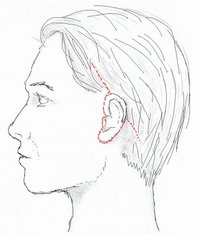Facelift (firming and tightening the skin of the face)
As the years pass, the skin of the face becomes less elastic and begins to form wrinkles. Smoking, UV light, weight changes as well as genetic factors can accelerate this ageing process. The muscles relax, fat accumulates along the jawline and the lines of the nose and chin get deeper. Tightening and firming the skin of the face and the neck, and strengthening the facial muscles can improve these problems.
At the same time, mini liposuction is often performed in the chin and jaw area to improve rejuvenation.
A facelift can be combined with other operations such as eyelid surgery (upper and lower eyelid blepharoplasty).
A facelift will not repair skin damage resulting from acne or fine wrinkles. However, skin treatment such as a dermabrasion, laser therapy or chemical peeling can be combined with a facelift to improve and enhance the appearance of the skin.
The Operation
The incision line of the skin is made at the hair line, level with the temples, in front of the ear, around the lobe and then continues behind the ear and ends in the hair.
The tissue that is situated underneath the skin (called the SMAS Sub Muscular Aponevrotic System) is where the muscles and fat layers are tightened and the excess skin removed.
The incision is sutured with threads, which are absorbed by the skin, and occasionally a hook-and-loop fastening is used within the hair.
Length of the facelift operation
A facelift takes approximately 3 to 4 hours, depending on the complexity of the operation. A facelift can be performed under local or general anaesthetic.
Outpatient or Inpatient?
A facelift is usually performed in an outpatient surgery centre (also known as a same-day surgery centre). It depends on the scale of the operation.
Pain after the operation
A facelift is a very long operation but usually the patient feels well and does not complain about excessive pain. An appropriate medication will be given for pain relief.
Recovery
After the operation, the patient will get a bandage/dressing for 1-2 days, with a little drainage that will be removed at the same time as the bandage/dressing. Postoperative swellings disappear within a few days and bruising/blotches within 2 weeks. The swellings and bruising resulting from eyelid operations are more visible. The patient feels a tension and a loss of sensitivity in the skin, which should return to normal within a few weeks. Due to redness, the skin scars may remain visible for a few months, until they fade.
Duration of Lasting Results
The period will differ for every patient. Some individuals will only require one facelift in their lifetime, but for others a repetition of the intervention might be useful after 5-10 years.
Risks
There may be some bleeding after the operation, but it is rare. Excessive haemorrhaging may require further intervention to drain the blood. Infections are rather rare. Blood circulation problems of the wound area (especially in the case of smokers) can result in the death of tissue (=necrosis). Some patient’s skin reacts with excessive scarring to injuries. With alternative interventions, excessive scarring can be lessened. Sometimes a corrective intervention may be required.
Occasionally, there can be injury to the nerves that control facial muscles, which may lead to partial paralysis of the skin, but these are usually temporary. A loss of sensitivity where the skin was detached is usually temporary.
The sensitivity will return after a few months. In the region of the ear it can be permanent.
